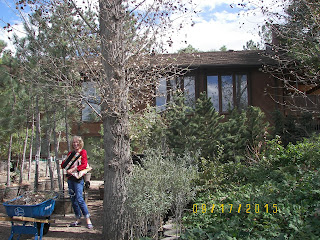First, cut your strips ahead of time, before we meet, if possible, at 2 1/2 inches. Each strip set makes 2 blocks, each block is approx. 8 inches unfinished. Cut your strips from WOF, or you can piece shorter strips.
I used this Companion Angle ruler, by Darlene Zimmerman - it is perfect for the job. If you have one for "side setting triangles" (Fons and Porter) that will also work. I am not familiar with other rulers but I'm sure there are many.
Sew one light and one dark strip together, using 1/4 in. seam allowance, press to the dark.
Good tip! See that orange bit of tape? I placed it on the back of my ruler with the tape's top edge at the 2 1/4 in. line. It is thick and kinda catches at the right place. Be careful - there are a lot of numbers, lines, but the one I am interested in is the 2 1/4 line -- it is in the center of this ruler, and that will be the matching point so it should be exact. The line on the ruler indicates 2 1/2 and shows the arrow down -- you want to pay attention to the mark above the orange tape. Very important. (The tape is a quarter inch in width. )
Above is the ruler position for the first cut, and below, flip your ruler around, for the second cut. Use your rotary cutter. Be sure the seam line (where the stitches are) is always at the 2 1/4 in. line. As you move along the strip set you might need to "clean up" your cutting line just a tad, now and then. Don't get mixed up with the 2 1/4 in. line when you flip your ruler around.
You should get 8 wedges from each WOF.
Lay the block out - I'm using a variety of combinations. I found it best to make/sew one block at a time. Lay the 2 quarters together, and run it through machine, starting at large dark end first, so that the seam that was pressed to the dark, goes into the machine facing away from you. Use care as these edges now are all bias. Note that (below) both halves are in the same configuration - be consistent.
Sew the 2 halves together, matching intersections. I finger pressed these - you might want to put a pin at intersections. The seams all abut each other neatly. You may have to stretch a tiny bit here and there, to ensure good intersection, but since they are bias, matching is easy. Be gentle.
Be consistent with how you feed the blocks into the machine. Can you see where I removed the last 2-3 stitches on that last seam with my seam ripper (below)? Pull them out on one side (seam ripper), then flip the block over and remove them out on the other side - don't trim the threads. Open the tiny center seam up, and press all seams in a clockwise direction, press all flat. The center will press neatly as well. If you have been consistent with your sewing, pressing and sending them thru your machine consistently, as above, they will ALL line up with each other as you put all your rows and blocks together, and all seams will abut and lie flat. If they don't, relax and have fun anyway!
At this point I am using a variety of fabrics, anything that a child will enjoy - I am not concentrating on one color or a "perfect" quilt - I just want it to bring pleasure to a child. I will spread my various blocks around. I may set them on point. You might aim for a quilt that is 5 x 6, about 37" x 44" or so, or 30 blocks, then plus border. That would be a generous size quilt. Perhaps 4 x 5, plus border? Your decision. The blocks finish at 7.5 in.
For the group, if you wish to participate, bring your supplies, pre-cut strips, and if you don't have enough fabric, feel free to use some of my pre-cut strips or fabric - I have plenty. You may also borrow my rulers for our time together, if needed. My fabrics tends to be mostly young boyish fabrics. That Companion Angle ruler is one of the less expensive and I use mine a lot - it was a good purchase many years ago.
See ya soon!




















































